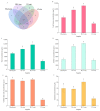Effect of Deacidification Treatment on the Flavor Quality of Zaosu Pear-Kiwifruit Wine
- PMID: 35885250
- PMCID: PMC9324503
- DOI: 10.3390/foods11142007
Effect of Deacidification Treatment on the Flavor Quality of Zaosu Pear-Kiwifruit Wine
Abstract
Conventional pear-kiwifruit wine has a bland flavor and sour taste, because of excessive l-malic acid content and, consequently, little consumer appeal. An Oenococcus oeni strain, GF-2, has good malolactic fermentation (MLF) performance and high glucosidase activity. Through a Box-Behnken design, the optimum MLF parameters for deacidification by GF-2 were determined: initial pH of 3.4, 5% v/v inoculation, and temperature of 20 °C, which reduced the malic acid content by 98.3%. The changes in the content of organic acids, polyphenols, and aromatic compounds after MLF were compared with chemical deacidification. MLF significantly decreased the total concentration of organic acids by 29.7% and promoted the accumulation of aromatic esters, higher alcohols, and terpenoids, but chemical deacidification markedly decreased aromatic compound content by 59.8%. MLF wine achieved the highest sensory scores for aroma, taste, and overall acceptability. Therefore, MLF with O. oeni GF-2 has great potential to markedly improve the quality of commercial pear-kiwifruit wine.
Keywords: Oenococcus oeni; chemical composition; malolactic fermentation; pear–kiwifruit wine; sensory evaluation.
Conflict of interest statement
The authors declare no conflict of interest.
Figures





Similar articles
-
Induction of simultaneous and sequential malolactic fermentation in durian wine.Int J Food Microbiol. 2016 Aug 2;230:1-9. doi: 10.1016/j.ijfoodmicro.2016.04.006. Epub 2016 Apr 13. Int J Food Microbiol. 2016. PMID: 27104664
-
Malolactic fermentation of lactic acid bacteria isolated from southern Brazilian red wine.World J Microbiol Biotechnol. 2023 May 19;39(8):201. doi: 10.1007/s11274-023-03645-w. World J Microbiol Biotechnol. 2023. PMID: 37202540
-
Effects of inoculation timing and mixed fermentation with Pichia fermentans on Oenococcus oeni viability, fermentation duration and aroma production during wine malolactic fermentation.Food Res Int. 2022 Sep;159:111604. doi: 10.1016/j.foodres.2022.111604. Epub 2022 Jul 1. Food Res Int. 2022. PMID: 35940798
-
Genomic variations of Oenococcus oeni strains and the potential to impact on malolactic fermentation and aroma compounds in wine.Appl Microbiol Biotechnol. 2011 Nov;92(3):441-7. doi: 10.1007/s00253-011-3546-2. Epub 2011 Aug 26. Appl Microbiol Biotechnol. 2011. PMID: 21870044 Review.
-
Improving Oenococcus oeni to overcome challenges of wine malolactic fermentation.Trends Biotechnol. 2015 Sep;33(9):547-53. doi: 10.1016/j.tibtech.2015.06.008. Epub 2015 Jul 18. Trends Biotechnol. 2015. PMID: 26197706 Review.
Cited by
-
Comparison of Aroma and Taste Profiles of Kiwi Wine Fermented with/without Peel by Combining Intelligent Sensory, Gas Chromatography-Mass Spectrometry, and Proton Nuclear Magnetic Resonance.Foods. 2024 May 31;13(11):1729. doi: 10.3390/foods13111729. Foods. 2024. PMID: 38890957 Free PMC article.
-
Comparing the Volatile and Soluble Profiles of Fermented and Integrated Chinese Bayberry Wine with HS-SPME GC-MS and UHPLC Q-TOF.Foods. 2023 Apr 6;12(7):1546. doi: 10.3390/foods12071546. Foods. 2023. PMID: 37048367 Free PMC article.
-
Editorial to Special Issue-Food Brewing Technology and Brewing Microorganisms.Foods. 2023 Sep 4;12(17):3324. doi: 10.3390/foods12173324. Foods. 2023. PMID: 37685256 Free PMC article.
-
Effect of Apple Cultivar and Selected Technological Treatments on the Quality of Apple Distillate.Foods. 2023 Dec 15;12(24):4494. doi: 10.3390/foods12244494. Foods. 2023. PMID: 38137298 Free PMC article.
References
-
- Zhang S.L., Xie Z.H. Current status, trends, main problems and the suggestions on development of pear industry in China. J. Fruit Sci. 2019;36:1067–1072. doi: 10.13925/j.cnki.gsxb.20190033. - DOI
-
- Song X.Y., Li J.C., Yang X.S., Zhu X. Effects of different blended ratios on aroma compounds of Zaosu pear-kiwi mixed fruit wine. Food Ferment Sci. Technol. 2021;57:39–50.
-
- FAO Statistics of Kiwifruit Area Harvested, Production and Yields in Countries Around yhe World, FAOSTAT, Food and Agriculture Organization. 2019. [(accessed on 22 June 2020)]. Available online: http://data.un.org/Data.aspx?q=KIWI&d=FAO&f=itemCode%3a592.
-
- Huang C.H., Tao J.J., Liao G.L., Xie M., Qu X.Y., Chen L., Xu X.B. Dynamic changes of phenol and antioxidant capacity during fruit development of three Actinidia species (kiwifruit) Sci. Hortic. 2020;273:109571. doi: 10.1016/j.scienta.2020.109571. - DOI
-
- Cai L.Q., Wang W.J., Tong J.W., Fang L.P., He X.F., Xue Q., Li Y.H. Changes of bioactive substances in lactic aci-d bacteria and yeasts fermented kiwifruit extract during the fermentation. LWT Food Sci. Technol. 2022;164:113629. doi: 10.1016/j.lwt.2022.113629. - DOI
Grants and funding
LinkOut - more resources
Full Text Sources

